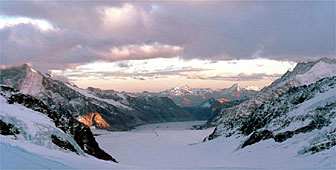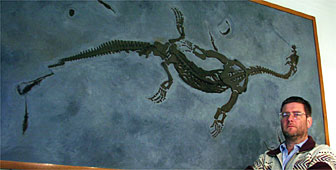Dinosaur site wins Unesco accolade

The Ticinese region of Monte San Giorgio is to be listed as a Unesco world heritage site.
Monte San Giorgio, which lies on the southern shore of Lake Lugano, is famous for its abundance of well-preserved reptile and fish fossils.
In the late 19th century, miners began digging for bituminous shale on the Italian side of Monte San Giorgio in order to extract oil to light the street lamps of Milan.
What they found, however, were the skeletons of marine reptiles and fish dating from the mid-Triassic period, around 240 million years ago.
Since then, thousands of fossils have been recovered, including that of a 2.5-metre-llong reptile called the Ceresiosaurus, and the remarkably well-preserved flipper of an ichthyosaur.
Unique contribution
Switzerland first put Monte San Giorgio forward for Unesco recognition in 2001. In order to qualify, a site – either natural or cultural – must be considered to be of outstanding universal value.
Unesco will make its official announcement on July 5, but Marco Molinari, a member of the Swiss delegation to Unesco, told swissinfo the decision to list Monte San Giorgio had been unanimous.
“With this decision Unesco has recognised the natural value of the Monte San Giorgio region,” Molinari said. “The fossils there are unique among finds from the mid-Triassic period.”
Monte San Giorgio is only the second natural site in Switzerland to qualify for Unesco’s world heritage list. The first is the Aletsch, Europe’s longest glacier, which qualified last year.
Four Swiss sites are already on Unesco’s cultural world heritage list: the Convent of St Gallen, Bern’s old town, the castles of Bellinzona and the Benedictine Convent of St John in Müstair.
Not just old bones
As well as its famous fossils, Monte San Giorgio has other natural attributes.
The region has recorded more than 550 species of fungi and three species of spiders were first discovered and scientifically recorded there.
The main fossil finds from Monte San Giorgio can be seen in the museums of palaeontology in Zurich, Lugano and Milan.
swissinfo with agencies
Over 10,000 fossils have been found at Monte San Giorgio since the late 19th century.
They were first discovered by miners digging up bituminous shale to extract oil.
They date from the mid-Triassic period, around 240 million years ago.
Monte San Giorgio follows the Aletsch glacier to become Switzerland’s second natural world heritage site.

In compliance with the JTI standards
More: SWI swissinfo.ch certified by the Journalism Trust Initiative


You can find an overview of ongoing debates with our journalists here . Please join us!
If you want to start a conversation about a topic raised in this article or want to report factual errors, email us at english@swissinfo.ch.